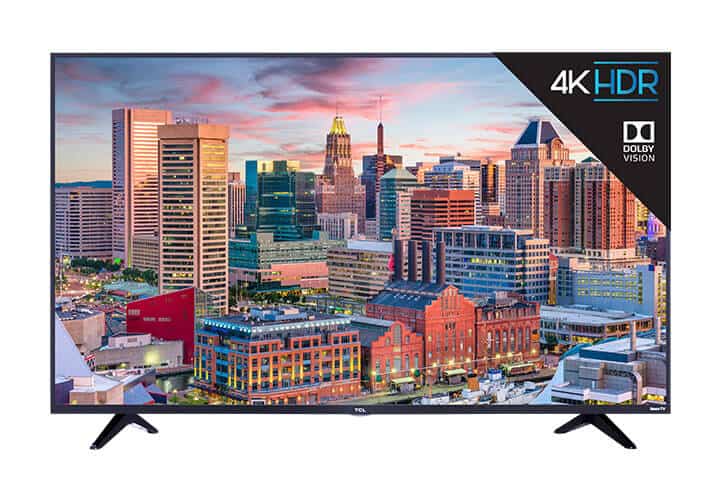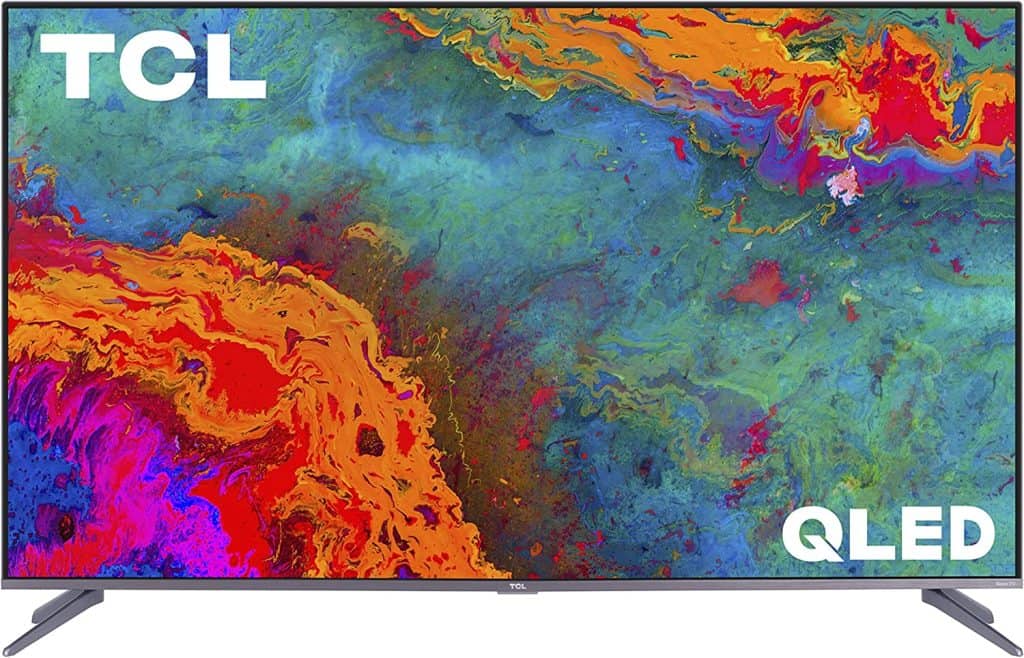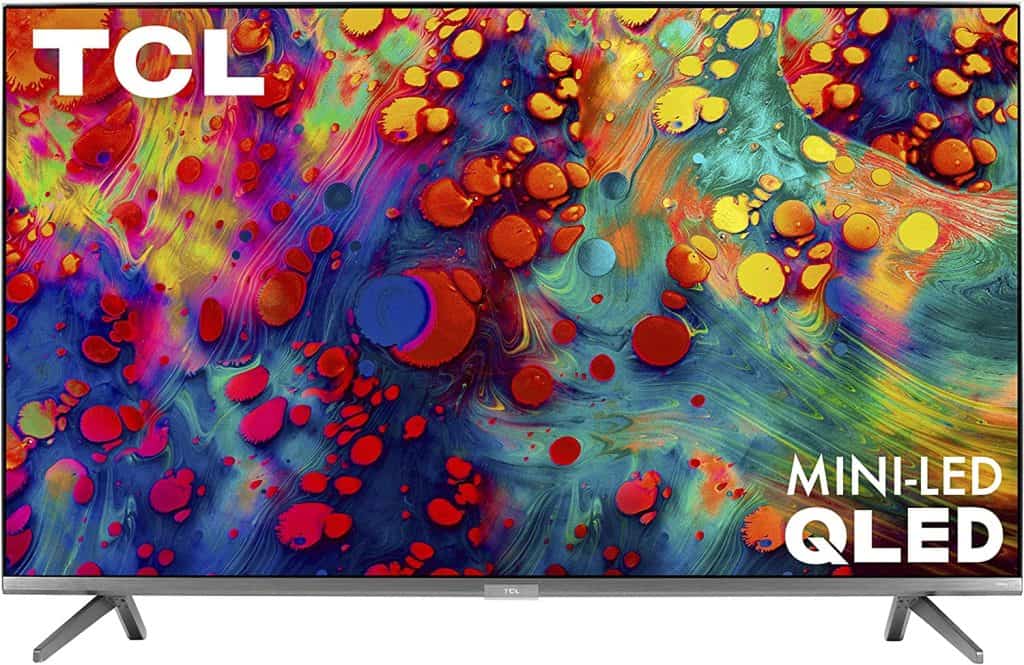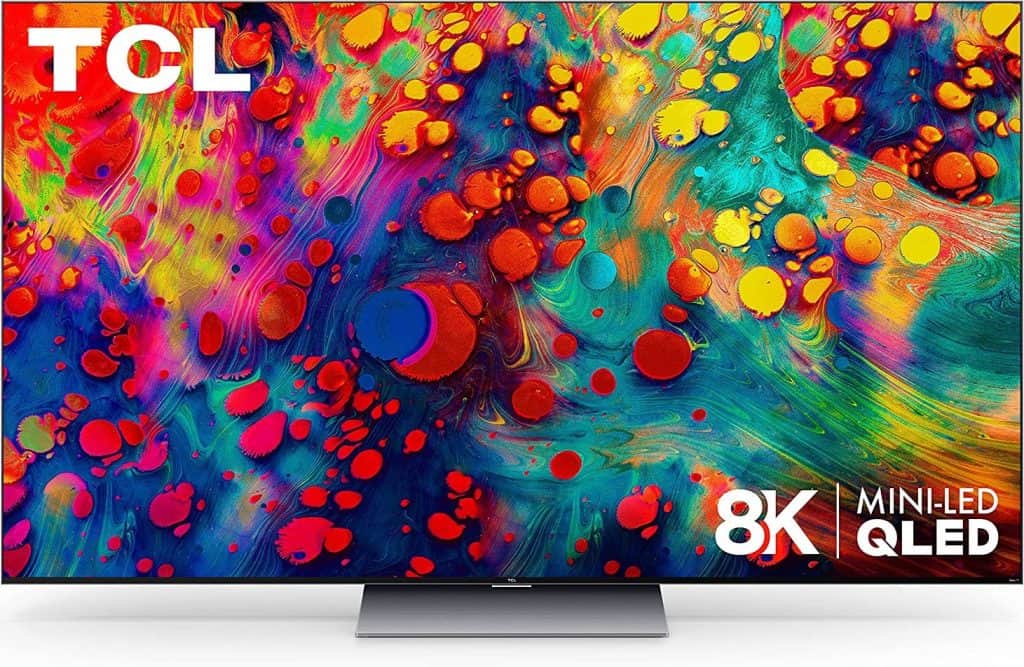TCL has long been the go-to brand for those looking for quality Roku TVs. The 5 Series and 6 Series models perfectly exemplify this by delivering all-around TVs suitable for mixed usage. While models from these two lineups have more similarities than dissimilarities, their differences are crucial to know before making your purchase. Read our detailed TCL 5 Series vs 6 Series comparison page to learn the ins and outs of these budget-friendly models.
TCL 5 Series vs 6 Series – Quick Comparison
TCL 5 Series
In this direct TCL 5 Series vs 6 Series comparison, the 5 Series is the more budget-friendly option. With the addition of a QLED model in 2020, the 5 Series offers excellent image quality at reasonable prices by sacrificing some performance features. The most significant advantages and drawbacks of this series are:
Pros:
- Dolby Vision and Dolby Atmos
- Very affordable for a model of its features
- Comes with built-in Roku
- Premium design and build
Cons:
- Poor viewing angles
- Lacks unique gaming settings
TCL 6 Series
Although TCL is generally regarded as a budget brand, the 6 Series targets consumers with a bigger budget and comes at a significantly higher price than the 5 Series. With this in mind, they also come with increased performance characteristics in all major categories, primarily when it comes to gaming. Here are the biggest pros and cons of the TCL 6 Series:
Pros:
- Dolby Vision and Dolby Atmos
- FreeSync, G-SYNC, and VRR
- Comes with built-in Roku
- Mini-LED backlighting
Cons:
- Terrible viewing angles
- Fairly poor image processor
TCL 5 Series
Price
TCL models from the 5 Series come at very affordable prices. TVs from this series are more budget-friendly than what many other brands are offering. Even in the context of the 5 Series vs 6 Series comparison, the 5 Series models are always the wiser choice if you’re looking for a solid TV on a tighter budget.
Panel Technology
Up until 2020, TCL models from the 5 Series have used traditional LED VA panels. However, with the addition of the 2020 5 Series models, the company has manufactured these TVs with QLED panel technology. These are still VA panels, only with stronger performance capabilities.
Image Processor
TCL 5 Series models come with an AiPQ Engine processor, a lackluster piece of hardware that is not nearly as fast or capable as image processors that come with other modern TVs. Recently, TCL announced AiPQ Engine Gen 2 processors, which will hopefully be included in future 5 Series models.
Motion Technology
TCL 5 Series models have very good response times, so you can expect most fast-moving content to look smooth on these TVs. However, they are a bit slower with fully dark transitions, leading to some noticeable short blur-trails.
Picture Quality
Contrast Ratio / Black Level
Whether LED or QLED, TCL 5 Series TVs have an above-average contrast ratio. They can produce deep blacks even if you’re watching content in the dark. That said, it’s important to note that specific contrast ratio numbers will vary depending on the 5 Series unit and year of production.
Local Dimming
TCL 5 Series models with QLED screens have a decent local dimming feature. These models can reduce brightness around subtitles and have significantly less blooming, even compared to models from the 6 Series. The earlier models like the 2019 TCL 5 Series don’t have a local dimming feature, as they have a direct backlight and not a full-array backlight like the 2020 and later models.
Peak Brightness
Peak brightness is one category in which the 5 Series falls significantly behind the 6 series. Both the 2020 QLED models and earlier LED models have subpar SDR and HDR brightness. In most situations, these TVs can’t get bright enough to combat glare. This makes them a poor choice if you’re planning on putting your new TV in a room that’s even slightly bright.
Color
The TCL 5 Series excels at displaying a wide color gamut. This makes it an excellent choice for watching 4K UHD content. It also delivers a decent color volume. Models from the 5 Series can generally produce deep and saturated colors without many issues but struggle to display bright blues.
Viewing Angle
This is a category in which both the 5 Series and the 6 Series fail to perform. That said, this comes as no surprise, as VA panels generally offer inferior viewing angles compared to other types of panels. If you have a wide seating arrangement, you’ll likely be disappointed with how quickly these TVs lose image accuracy as you move off-center.
Reflections / Anti-glare
The TCL 5 Series has decent reflection handling properties. Models from this series feature a semi-gloss screen finish, which isn’t the best type of coating but gets the job done in most situations. The TVs can partly diffuse most reflections, but you should still expect some amount of light to reflect off of the screen, even in a moderately lit room.
Sound Quality
The built-in speakers that come with the 5 Series TVs are just okay and nothing more than that. The speakers can get reasonably loud and have a well-balanced profile. However, the bass that they produce often feels flat and fails to deliver the desired rumble. So, if you opt for a TV from the 5 Series, you should consider pairing it with a soundbar for a better audio experience.
Smart TV Platform (Operating System)
TCL 5 Series TVs use the Roku TV OS, an operating system that’s very streamlined, easy to navigate, and user-friendly. Nevertheless, Roku TV offers a good selection of advanced options and a great selection of apps. Series 5 models can deliver HDR content on both Netflix and YouTube.
Connectivity
Inputs
TCL 5 Series models come with a good variety of inputs. Most TVs from this lineup come with four HDMI ports, at least one USB port, and an Ethernet port, among other features. Equally as important, TCL 5 Series models have outstandingly low input lag.
Voice Assistants
The TCL 5 Series remote doesn’t have a built-in microphone that you can use for voice control. Though you can still control these TVs through the Roku app on your phone or tablet device, this is a bit of a drawback. Still, the voice assistant features available through the app are relatively basic and don’t stack up to what other TV manufacturers offer. There’s also Google Assistant/Amazon Alexa integration support.
Wireless Technologies
Standard to all newer TV models, TVs from the 5 Series line come with Wi-Fi support in 2.4GHz and 5.0GHz Wi-Fi. This allows you to conveniently pair many different devices to your TCL 5 Series TV.
Gaming Enhancements
The 5 Series is at a clear disadvantage compared to the 6 Series regarding gaming enhancements. Models from this lineup come with neither FreeSync nor G-SYNC compatibility. Furthermore, these TVs don’t offer VRR support, a crucial feature for everyone looking for an immersive gaming experience.
Recommended TCL 5 Series TVs
TCL S515 2019

When talking about 4K TVs, finding a model with such a resolution for under $500 often leads to poor performance and disappointing results. That said, the 2019 TCL S515 model is a perfect example of an affordable-yet-quality 4K TV with decent all-around performance. It delivers solid sound performance, HDR picture with Dolby Vision, and, of course, built-in Roku TV. All of this provides you with excellent value for money not many other TVs can match.
TCL S535 2020 QLED

The 2020 QLED TCL 5 Series is one of the cheapest QLED TVs you can get, allowing you to enjoy all of the benefits of a 4K TV at a price of just around $600 or less. The TV comes with HDR Pro Pack featuring Dolby Vision, Dolby Atmos, and built-in Roku. Additionally, it has handy features like Contrast Control Zone technology that maximizes contrast and delivers superior picture quality. This makes it an excellent entertainment center right out of the box.
Related Read: TCL 4 Series vs 5 Series: Which budget TV should you choose?
TCL 6 Series
Price
If price is one of the main deciding factors for you when choosing between these two series, you should primarily focus on models from the 5 Series. TCL models from the 6 Series are at least a couple of hundred dollars more across all available display sizes.
Panel Technology
Like models from the 5 Series, TCL models from the 6 Series have used traditional LED VA panels until 2020. And, since the 2020 6 Series models, the company has manufactured these TVs with QLED panel technology. So, when it comes to panel technology, you can expect the same panel types regardless of whether you opt for a 5 Series or 6 Series model.
Image Processor
TCL 6 Series TVs come with the same uninspiring processor as the 5 Series models, the AiPQ Engine processor. This processor delivers okay processing power, but not nearly as much as is expected from a TV with the capabilities of a 6 Series model. In this category, the 5 Series and 6 Series models equally underperform.
Motion Technology
Although models from the 5 Series have very good performance times, the 6 Series has an even more impressive response time. Moreover, TCL continuously improves the series, as these TVs have better and better response times with each passing year. Taking the 2020 6 Series model as an example, it has minimal motion blur and a full transition time of just over 11 milliseconds.
Picture Quality
Contrast Ratio / Black Level
TCL 6 Series has an excellent contrast ratio. The 2020 model is particularly impressive, as it can produce deep blacks that are striking even for a VA panel. Additionally, the local dimming feature allows for additional contrast improvement, allowing almost twice as better contrast than native contrast settings.
Local Dimming
The TCL 6 Series has slightly better full-array local dimming capabilities than the 5 Series. Surprisingly, the 2019 6 Series models have a more capable local dimming algorithm than the 2020 models. There’s some noticeable blooming around subtitles, although it seems better-managed compared to the 5 Series.
The 6 Series is superior in terms of local dimming because it features a Mini-LED technology, which allows more effective contrast control than a traditional full-array LED display.
Peak Brightness
The 6 Series has impressive peak brightness, both in SDR and HDR categories. Models from this series can get significantly brighter than those from the 5 Series. While you may notice some consistency issues in peak fullscreen brightness, TVs from the 6 Series can get pretty bright for a VA panel.
Color
Though 5 Series models can display a wide color gamut with relatively rich color volumes, the 6 Series brings this to an entirely different level, which is why 6 Series TVs have the edge in this category as well. TVs from this series have exceptional coverage of the DCI P3 color space and solid coverage of the Rec. 2020 color space. Still, they suffer from the same flaw that plagues all LED TVs, and that is that they can’t display extremely bright blues.
Viewing Angle
As expected from a VA panel, the 6 Series has poor viewing angles. What is a bit surprising is that the 6 Series is even worse than the 5 Series in this category. TVs from this lineup start losing brightness already at around thirty degrees, and you will quickly notice image accuracy loss as soon as you move a bit to the side. With that in mind, these TVs are not suitable for a wide seating arrangement in the slightest.
Reflections / Anti-glare
As the 6 Series has the same semi-gloss screen finish that comes on the 5 Series models, reflection handling properties are nearly identical. This entails decent reflection handling and anti-glare properties with reasonably good performance in moderately lit rooms but relatively poor if faced with direct sunlight.
Sound Quality
Series 6 models have slightly better speakers with superior frequency response. The bass can get noticeably lower, though still not heavy enough to match up with the best-performing TVs in this category. Series 6 TVs have a striking maximum volume and perform excellently even in a noisy environment.
Smart TV Platform (Operating System)
Like the 5 Series, models from the 6 Series use the same Roku TV Smart OS. That said, the specific OS version will vary from model to model. In this sense, 6 Series models have as many advanced apps, run equally as smooth, and are identically straightforward to navigate as their 5 Series counterparts.
Connectivity
Inputs
Input availability and layout is another category where the 6 Series is identical to the 5 Series. TVs from this lineup come with four HDMI ports, one USB port, and an Ethernet port. They also offer remarkably low input lag, especially if you turn on Game Mode.
Voice Assistants
As they come with the same type of remote as the 5 Series models, 6 Series TVs have the same voice assistant properties. You have to set up the Roku app on your mobile device, as the remote lacks any voice assistant capabilities. Additionally, you can take advantage of the Google Assistant/Amazon Alexa integration support and set up voice control features through this option.
Wireless Technologies
When it comes to wireless technologies, there’s not much room for differentiation between rivaling series. So, the 6 Series comes with the same Wi-Fi support (2.4GHz and 5GHz) as the 5 Series models.
Gaming Enhancements
As we’ve mentioned above, the 6 Series is a much better performer in gaming. This is because it offers both FreeSync and G-SYNC compatibility. It also has a variable refresh rate feature, allowing it to synchronize its refresh rate and reduce immersion-breaking occurrences like screen tearing and image stuttering.
Recommended TCL 6 Series TVs
TCL 6 Series 2020 4K QLED

The 2020 6 Series QLED model is the epitome of the 6 Series characteristics we’ve discussed above. It improves many of 2019’s features to deliver a model with superior 4K HDR picture quality and plenty of advanced features. Speaking of the latter, the most notable features include Mini-LED backlight technology, HDR Pro Pack for stunning visuals, and VRR for seamless gameplay.
TCL 6 Series 2021 8K QLED

Looking at the sheer specs of this model, the 2021 8K QLED 6 Series model is an excellent choice for all 8K enthusiasts. It comes with the recognizable 6 Series Mini-LED lightning setup, allowing for an exceptional contrast ratio. It can create beautiful and in-depth images perfect for streaming content or playing games. To top this off, it’s arguably the cheapest 8K QLED TV you can find.
See Also: TCL R615 vs R617: How different are these two TVs?
Conclusion
As the more expensive TV model in this TCL 5 Series vs 6 Series comparison, the latter series is undoubtedly the better performer. Models from the 6 Series offer better quality in most major categories we’ve tested and featured above. Of course, there’s no avoiding the price factor in this comparison. In this case, TVs from the TCL 5 Series have a clear advantage of being noticeably cheaper.
If the price of your new TV isn’t one of the determining factors when making your decision, TVs from the 6 Series are worth the extra couple of hundred dollars you will need to shell out. They are brighter, better-performing, have more capable motion handling capabilities, and are more suitable for gaming.
Hey Jon, your editorial explaining the difference between the TCL 5 and 6 series smart tv’s, is very informative and greatly influenced my decision on which one to buy.. thanks. I think I read that the 6 series has a “brushed metal” tv frame… is that true?
Hi Manuel, thanks for the kind words. I’m glad we could help! And, yes you are correct– the TCL 6 Series does indeed have a brushed metal frame! 🙂
Does the 5 series truly have Dolby Atmos? TCL says it does NOT, but I have seen several reviewers saying it DOES.
Hi ARM– yes, indeed the TCL 5 Series DOES have Dolby Vision and Atmos. See the below link. Where are you seeing that TCL says it doesn’t?
https://www.tcl.com/us/en/products/home-theater/5-series/55-class-5-series-4k-qled-hdr-smart-google-tv-55s546#:~:text=DOLBY%20VISION%C2%AE%C2%A0%26%C2%A0DOLBY,immersive%20surround%20sound.